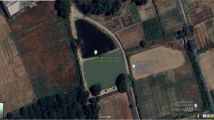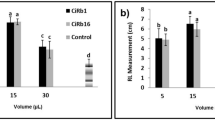Abstract
The plant beneficial mechanisms shown by rhizobacteria are remarkable in its nature, distribution and execution. In the study, 11 rhizospheric bacterial isolates of Cyclea peltata (Indian moon-seed) were found to have strong inhibitory activity against Pythium myriotylum and Rhizoctonia solani. Among these, two Pseudomonas spp. (K6 and DN18) were identified to have a differential distribution of antifungal mechanisms. By LC–MS analysis, K6 and DN18 have been confirmed for the presence of metabolites such as phenazine-1-carboxylic acid (PCA), mono-rhamnolipid and di-rhamnolipid, 1-hydroxy phenazine, pyocyanin and pyrrolnitrin. Due to the well-demonstrated antifungal mechanisms of these compounds, the natural logic behind its rhizospheric presence can primarily be plant protective. A further molecular investigation has resulted in the identification of the gene responsible for rhamnolipid biosynthesis in Pseudomonas spp. K6 and DN18. In addition, isolate K6 has been confirmed for the production of chitinase in colloidal chitin agar. The wide range of chemical and enzymatic antifungal mechanisms shown by the isolated Pseudomonas spp. have also been found to offer growth enhancement and suppression of disease caused by Sclerotium rolfsii in cowpea (Vigna unguiculata (L.) Walp.) plants which make the study significant. Because of the enormous potential to control phytopathogens and augment plant growth, these candidate organisms can have field application potential.



Similar content being viewed by others
References
Abdel-Mawgoud AM, Lépine F, Déziel E (2010) Rhamnolipids: diversity of structures, microbial origins and roles. Appl Microbiol Biotechnol 86:1323–1336
Behravan J, Jami Al Ahmadi K, Tabatabaei Yazdi M, Fathi Najafi M, Shahverdi AR, Faramarzi MA, Zarrini G (2008) Optimization of medium and cultivation conditions for Chitinase production by the newly isolated: Aeromonas sp. Biotechnology (faisalabad) 7:266–272
Cappuccino JG, Sherman N (2014) Microbiology : a laboratory manual. Pearson, Boston
Cheng T, Liang J, He J, Hu X, Ge Z, Liu J (2017) A novel rhamnolipid-producing Pseudomonas aeruginosa ZS1 isolate derived from petroleum sludge suitable for bioremediation. AMB Express. https://doi.org/10.1186/s13568-017-0418-x
Cheruiyot KR, Olila D, Kateregga J (2009) In-vitro antibacterial activity of selected medicinal plants from Longisa region of Bomet district. Kenya Afr Health Sci 9(Suppl 1):S42-46
Chin-A-Woeng TFC, Bloemberg GV, van der Bij AJ, van der Drift KMGM, Schripsema J, Kroon B, Scheffer RJ, Keel C, Bakker PAHM, Tichy H-V, de Bruijn FJ, Thomas-Oates JE, Lugtenberg BJJ (1998) Biocontrol by phenazine-1-carboxamide-producing Pseudomonas chlororaphis PCL1391 of tomato root rot caused by Fusarium oxysporum f. sp. radicis-lycopersici. Mol Plant Microbe Interact 11:1069–1077
Chin-A-Woeng TFC, Bloemberg GV, Lugtenberg BJJ (2003) Phenazines and their role in biocontrol by Pseudomonas bacteria. New Phytol. 157(3):503-523. https://doi.org/10.1046/j.1469-8137.2003.00686.x
Chun J, Goodfellow M (1995) A phylogenetic analysis of the genus Nocardia with 16S rRNA gene sequences. Int J Syst Bacteriol 45:240–245
Ganeshan G, Manoj Kumar A (2005) Pseudomonas fluorescens, a potential bacterial antagonist to control plant diseases. Journal of Plant Interactions 1:123–134
Garampalli R, Seema HS, Sunil Kumar CP (2012) Diversity of arbuscular mycorrhizal fungi associated with some medicinal plants in Western Ghats of Karnataka region, India. World Journal of Science and Technology 2:13–20
Gudina EJ, Teixeira JA, Rodrigues LR (2010) Isolation and functional characterization of a biosurfactant produced by Lactobacillus paracasei. Colloids Surf B 76:298–304
Heil M (2002) Induced systemic resistance (isr) against pathogens in the context of induced plant defences. Ann Bot 89:503–512
Islam S, Akanda AM, Prova A, Islam MT, Hossain MM (2016) Isolation and identification of plant growth promoting rhizobacteria from cucumber rhizosphere and their effect on plant growth promotion and disease suppression. Front Microbiol. https://doi.org/10.3389/fmicb.2015.01360
Jasim B, Anisha C, Rohini S, Kurian JM, Jyothis M, Radhakrishnan EK (2013a) Phenazine carboxylic acid production and rhizome protective effect of endophytic Pseudomonas aeruginosa isolated from Zingiber officinale. World J Microbiol Biotechnol 30:1649–1654
Jasim B, John Jimtha C, Jyothis M, Radhakrishnan EK (2013b) Plant growth promoting potential of endophytic bacteria isolated from Piper nigrum. Plant Growth Regul 71:1–11
Jimtha John C, Jishma P, Arathy GB, Anisha C, Radhakrishnan EK (2016) Identification of plant growth promoting Rhizosphere Bacillus sp. WG4 antagonistic to Pythium myriotylum and its enhanced antifungal effect in association with Trichoderma. Soil Sci Plant Nutr. https://doi.org/10.4067/S0718-95162016005000026
Jishma P, Hussain N, Chellappan R, Rajendran R, Mathew J, Radhakrishnan EK (2017) Strain-specific variation in plant growth promoting volatile organic compounds production by five different Pseudomonas spp. as confirmed by response of Vigna radiata seedlings. J Appl Microbiol 123:204–216
John CJ, Radhakrishnan EK (2017) Chemicobiological insight into anti-phytopathogenic properties of Rhizospheric Serratia plymuthica R51. Proc Natl Acad Sci, India, Sect B Biol Sci. https://doi.org/10.1007/s40011-017-0909-1
Khan MS, Zaidi A, Ahemad M, Oves M, Wani PA (2010) Plant growth promotion by phosphate solubilizing fungi—current perspective. Archives of Agronomy and Soil Science 56:73–98
L. JH (1942) Pro Line Soc. N.S.W. 57: 205–212
Lim SM, Yoon M-Y, Choi GJ, Choi YH, Jang KS, Shin TS, Park HW, Yu NH, Kim YH, Kim J-C (2017) Diffusible and volatile antifungal compounds produced by an Antagonistic Bacillus velezensis G341 against various phytopathogenic fungi. The Plant Pathology Journal 33:488–498
Mahato A, Biswas MK, Patra S (2018) Efficacy of medicinal plant extracts against collar rot of tomato caused by Sclerotium Rolfsii (Sacc.). Int J Microbiol Res 10(5):1224–1227. https://doi.org/10.9735/0975-5276.10.5.1224-1227
Mapelli F, Marasco R, Rolli E, Barbato M, Cherif H, Guesmi A, Ouzari I, Daffonchio D, Borin S (2013) Potential for plant growth promotion of Rhizobacteria associated with salicornia growing in Tunisian hypersaline soils. Biomed Res Int 2013:1–13
Mavrodi DV, Ksenzenko VN, Bonsall RF, Cook RJ, Boronin AM, Thomashow LS (1998) A seven-gene locus for synthesis of phenazine-1-carboxylic acid by Pseudomonas fluorescens 2–79. J Bacteriol 180:2541–2548
Millar RL (1970) Association of Cyanide with Infection of Birdsfoot Trefoil by Stemphylium loti. Phytopathology 60:104
Mulligan CN (2005) Environmental Applications for Biosurfactants. Environ Pollut 133:183–198
Nadeem SM, Naveed M, Zahir ZA, Asghar HN (2013) Plant-Microbe Interactions for Sustainable Agriculture: Fundamentals and Recent Advances. In: Arora NK (ed) Plant microbe symbiosis: fundamentals and advances. New Delhi, Springer India, pp 51–103
Nalini S, Parthasarathi R (2014) Production and characterization of rhamnolipids produced by Serratia rubidaea SNAU02 under solid-state fermentation and its application as biocontrol agent. Biores Technol 173:231–238
Novik G, Savich V, Kiselev E (2015) An Insight Into Beneficial Pseudomonas bacteria. In: Shah MM (ed) Microbiology in agriculture and human health. InTech, London
Ochsner UA, Reiser J, Fiechter A, Witholt B (1995) Production of Pseudomonas aeruginosa Rhamnolipid biosurfactants in heterologous hosts. Appl Environ Microbiol 61:3503–3506
Rahman MA, Begum MF, Alam MF (2009) Screening of trichodermaisolates as a biological control agent against Ceratocystis paradoxa causing pineapple disease of sugarcane. Mycobiology 37:277
Rahman A, Sitepu IR, Tang S-Y, Hashidoko Y (2014) Salkowski’s reagent test as a primary screening index for functionalities of Rhizobacteria isolated from wild dipterocarp saplings growing naturally on medium-strongly acidic tropical peat soil. Biosci Biotechnol Biochem 74:2202–2208
Raza ZA, Khalid ZM, Banat IM (2009) Characterization of rhamnolipids produced by a Pseudomonas aeruginosa mutant strain grown on waste oils. J Environ Sci Heal A 44:1367–1373
Saraf M, Pandya U, Thakkar A (2014) Role of allelochemicals in plant growth promoting rhizobacteria for biocontrol of phytopathogens. Microbiol Res 169:18–29
Siddiqui IA, Shaukat SS, Sheikh IH, Khan A (2006) Role of cyanide production by Pseudomonas fluorescens CHA0 in the suppression of root-knot nematode, Meloidogyne javanica in tomato. World J Microbiol Biotechnol 22:641–650
Someya N, Akutsu K (2006) Biocontrol of plant diseases by genetically modified microorganisms: current status and future prospects. In: Siddiqui ZA (ed) PGPR: Biocontrol and biofertilization. Springer, Dordrecht, pp 297–312
Surange S, Wollum Ii AG, Kumar N, Nautiyal CS (1997) Characterization of Rhizobium from root nodules of leguminous trees growing in alkaline soils. Can J Microbiol 43:891–894
Suthin Raj T, Muthukumar A (2019) In vitro and In vivo efficacy of culture filtrate of bacterial antagonists against Sclerotium rolfsii causing collar rot of peppermint. J Pharmacogn Phytochem 8(2):26–31
Tamura K, Peterson D, Peterson N, Stecher G, Nei M, Kumar S (2011) MEGA5: molecular evolutionary genetics analysis using maximum likelihood, evolutionary distance, and maximum parsimony methods. Mol Biol Evol 28:2731–2739
Upadhyay A, Srivastava S (2011) Phenazine-1-carboxylic acid is a more important contributor to biocontrol Fusarium oxysporum than pyrrolnitrin in Pseudomonas fluorescens strain Psd. Microbiol Res 166:323–335
Wang Y, Wilks JC, Danhorn T, Ramos I, Croal L, Newman DK (2011) Phenazine-1-carboxylic acid promotes bacterial biofilm development via ferrous iron acquisition. J Bacteriol 193:3606–3617
Wittgens A, Kovacic F, Müller MM, Gerlitzki M, Santiago-Schübel B, Hofmann D, Tiso T, Blank LM, Henkel M, Hausmann R, Syldatk C, Wilhelm S, Rosenau F (2017) Novel insights into biosynthesis and uptake of rhamnolipids and their precursors. Appl Microbiol Biotechnol 101(7):2865–2878. https://doi.org/10.1007/s00253-016-8041-3
Zhang Y, Miller RM (1992) Enhanced octadecane dispersion and biodegradation by a Pseudomonas rhamnolipid surfactant (biosurfactant). Appl Environ Microbiol 58:3276–3282
Acknowledgements
This study was financially supported by Kerala State Council for Science Technology and Environment (KSCSTE) under the KSCSTE-SRS Project Scheme. The authors also acknowledge the Inter-University Instrumentation Centre, Mahatma Gandhi University, Kottayam for the help and support in the LC-MS/MS analysis. Also acknowledge KSCSTE-KBC-YIPB, Kerala Plan Fund and Jaivam project for the facility and support.
Author information
Authors and Affiliations
Corresponding author
Ethics declarations
Conflict of interest
The authors declare that they have no conflict of interest.
Additional information
Publisher's Note
Springer Nature remains neutral with regard to jurisdictional claims in published maps and institutional affiliations.
Supplementary Information
Below is the link to the electronic supplementary material.
Rights and permissions
About this article
Cite this article
Jishma, P., Shad, K.S., Athulya, E. et al. Rhizospheric Pseudomonas spp. with plant growth promotion and antifungal properties against Sclerotium rolfsii mediated pathogenesis in Vigna unguiculata. Plant Biotechnol Rep 15, 483–491 (2021). https://doi.org/10.1007/s11816-021-00687-0
Received:
Revised:
Accepted:
Published:
Issue Date:
DOI: https://doi.org/10.1007/s11816-021-00687-0




